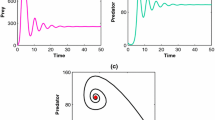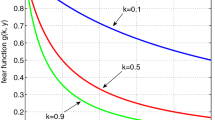Abstract
This paper concerns a Holling type II predator–prey system. We pay particular attention to the multi-factor influence including the Allee effect, fear effect, prey refuge and delay. The existence and stability of the equilibria of the system are investigated. Taking the prey refuge as a bifurcating parameter, a threshold condition is given for the local stability of the system without delay and show that the system may occur a supercritical Hopf bifurcation. Taking the delay as a bifurcating parameter, the delayed system undergoes a Hopf bifurcation at the positive equilibrium. The direction of Hopf bifurcation and the stability of bifurcating periodic solution are investigated by the center manifold theorem and normal form theory. We show that the delay, Allee effect, fear effect and prey refuge can enrich the dynamic behaviors. Our mathematical analysis shows that the influence of fear effect and Allee effect is negative, while the impact of the prey refuge is positive. Moreover, it shows that the delay can switch the stability of the system. Examples with their numerical simulations are given to illustrate our theoretical results.






Similar content being viewed by others
Data Availability
Our manuscript has no associated data.
References
Chen, F., Chen, W., Wu, Y., Ma, Z.: Permanence of a stage-structured predator–prey system. Appl. Math. Comput. 219(17), 8856–8862 (2013)
Chen, L., Chen, F.: Dynamic behaviors of the periodic predator–prey system with distributed time delays and impulsive effect. Nonlinear Anal. Real World Appl. 12(4), 2467–2473 (2011)
Zhang, N., Kao, Y., Chen, F., Fen, B., Li, S.: On a predator–prey system interaction under fluctuating water level with nonselective harvesting. Open Math. 18, 458–475 (2020)
Wu, R., Li, L., Lin, Q.: A Holling type commensal symbiosis model involving Allee effect. Commun. Math. Biol. Neurosci. 2018, 6 (2018)
Huang, J., Gong, Y., Chen, J.: Multiple bifurcations in a predator–prey system of Holling and Leslie type with constant-yield prey harvesting. Int. J. Bifurcat. Chaos 23, 1350164 (2013)
Huang, J., Xia, X., Zhang, X., Ruan, S.: Bifurcation of codimension 3 in a predator–prey system of Leslie type with simplified Holling type IV functional response. Int. J. Bifurcat. Chaos 26, 1650034 (2016)
Song, Y., Tang, X.: Stability, steady-state bifurcations and Turing patterns in a predator–prey model with herd behavior and prey-taxis. Stud. Appl. Math. 139(3), 371–404 (2017)
Yi, F., Wei, J., Shi, J.: Bifurcation and spatiotemporal patterns in a homogeneous diffusive predater–prey system. J. Differ. Equ. 246(5), 1944–1977 (2009)
Yan, S., Jia, D., Zhang, T., Yuan, S.: Pattern dynamics in a diffusive predator–prey model with hunting cooperations. Chaos Soliton. Fract. 130, 109428 (2020)
Yang, J., Zhang, T., Yuan, S.: Turing pattern induced by cross-diffusion in a predator–prey model with pack predation–herd behavior. Int. J. Bifurcat. Chaos 30, 2050103 (2020)
Zhang, T., Liu, X., Meng, X., Zhang, T.: Spatio-temporal dynamics near the steady state of a planktonic system. Comput. Math. Appl. 75(12), 4490–4504 (2018)
Holling, C.S.: The functional response of predator to prey density and its role in mimicry and population regulation. Can. Entomol. Suppl. 97(S45), 5–60 (1965)
Xu, R.: Global stability and Hopf bifurcation of a predator–prey model with stage structure and delayed predator response. Nonlinear Dyn. 67, 1683–1693 (2012)
Kar, T.K.: Stability analysis of a prey–predator model incorporating a prey refuge. Commun. Nonlinear Sci. Numer. Simul. 10(6), 681–691 (2005)
Jia, D., Zhang, T., Yuan, S.: Pattern dynamics of a diffusive toxin producing phytoplankton–zooplankton model with three-dimensional patch. Int. J. Bifurcat. Chaos 29, 1930011 (2019)
Peng, Y., Li, Y., Zhang, T.: Global bifurcation in a toxin producing phytoplankton–zooplankton system with prey-taxis. Nonlinear Anal. Real World Appl. 61, 103326 (2021)
Yu, X., Yuan, S., Zhang, T.: Survival and ergodicity of a stochastic phytoplankton–zooplankton model with toxin-producing phytoplankton in an impulsive polluted environment. Appl. Math. Comput. 347, 249–264 (2019)
Chen, L., Chen, F., Chen, L.: Qualitative analysis of a predator–prey model with Holling type II functional response incorporating a constant prey refuge. Nonlinear Anal. Real World Appl. 11, 246–252 (2010)
Zhang, H., Cai, Y., Fu, S., Wang, W.: Impact of the fear effect in a prey–predator model incorporating a prey refuge. Appl. Math. Comput. 356, 328–337 (2019)
Xiao, Z., Li, Z., Zhu, Z., Chen, F.: Hopf bifurcation and stability in a Beddington–DeAngelis predator–prey model with stage structure for predator and time delay incorporating prey refuge. Open Math. 17, 141–159 (2019)
Wei, F., Fu, Q.: Hopf bifurcation and stability for predator–prey systems with Beddington–DeAngelis type functional response and stage structure for prey incorporating refuge. Appl. Math. Model. 40(1), 126–134 (2016)
Chen, J., Zhang, T., Zhou, Y.: Dynamics of a risk-averse newsvendor model with continuous-time delay in supply chain financing. Math. Comput. Simul. 169, 133–148 (2020)
Xiao, Z., Xie, X., Xue, Y.: Stability and bifurcation in a Holling type II predator–prey model with Allee effect and time delay. Adv. Differ. Equ. 2018, 288 (2018)
Anacleto, M., Vidal, C.: Dynamics of a delayed predator–prey model with Allee effect and Holling type II functional response. Math. Methods Appl. Sci. 43(9), 5708–5728 (2020)
Zhu, Z., He, M., Li, Z., Chen, F.: Stability and bifurcation in a logistic model with Allee effect and feedback control. Int. J. Bifurcat. Chaos 30, 2050231 (2020)
Lai, L., Zhu, Z., Chen, F.: Stability and bifurcation in a predator–prey model with the additive Allee effect and the fear effect. Mathematics 8, 1280 (2020)
Guan, X., Chen, F.: Dynamical analysis of a two species amensalism model with Beddington–DeAngelis functional response and Allee effect on the second species. Nonlinear Anal. Real World Appl. 48, 71–93 (2019)
Wei, Z., Xia, Y., Zhang, T.: Stability and bifurcation analysis of an amensalism model with weak Allee effect. Qual. Theory Dyn. Syst. 19, 23 (2020)
Wei, Z., Xia, Y., Zhang, T.: Stability and bifurcation analysis of a commensal model with additive Allee effect and nonlinear growth rate. Int. J. Bifurcat. Chaos 31, 2150204 (2021)
Wang, X., Zannette, L., Zou, X.: Modelling the fear effect in predator–prey interactions. J. Math. Biol. 73(5), 1179–1204 (2016)
Sasmal, S.K.: Population dynamics with multiple Allee effects induced by fear factors—a mathematical study on prey–predator ineractions. Appl. Math. Model. 64, 1–14 (2018)
Huang, Y., Zhu, Z., Li, Z.: Modeling the Allee effect and fear effect in predator–prey system incorporating a prey refuge. Adv. Differ. Equ. 2020, 321 (2020)
Song, Y., Yin, T., Shu, H.: Dynamics of a ratio-dependent stage-structured predator–prey model with delay. Math. Meth. Appl. Sci. 40(18), 6451–6467 (2017)
Zhang, Z., Ding, T., Huang, W., Dong, Z.: Qualitative Theory of Differential Equation. Science Press, Beijing (1992).. (in Chinese)
Kuang, Y.: Delay Differential Equations with Applications in Population Dynamics. Academic Press, New York (1993)
Hassard, B.D., Kazarinoff, N.D., Wan, Y.H.: Theory and Applications of Hopf Bifurcation. Cambridge University Press, Cambridge (1981)
Song, Y., Wei, J.: Local Hopf bifurcation and global periodic solutions in a delayed predator–prey system. J. Math. Anal. Appl. 301, 1–21 (2005)
Song, Y., Jiang, H., Liu, Q., Yuan, Y.: Spatiotemporal dynamics of the diffusive Mussel–Algae model near Turing–Hopf bifurcation. SIAM J. Appl. Dyn. Syst. 16(4), 2030–2062 (2017)
Yi, F., Wei, J., Shi, J.: Diffusion-driven instability and bifurcation in the Lengyel–Epstein system. Nonlinear Anal. Real World Appl. 9(3), 1038–1051 (2008)
Kao, Y., Li, H.: Asymptotical multistability and locally S-asymptotical \(\omega \)-periodicity for the nonautonomous fractional-order neural networks with impulses. Sci. China Inform. Sci. 64(1), 175–187 (2021)
Li, H., Kao, Y., Bao, H., Chen, Y.: Uniform stability of complex-valued neural networks of fractional-order with linear impulses and fixed time delays. IEEE Trans. Neural Netw. Learn. Syst. (2021). https://doi.org/10.1109/TNNLS.2021.3070136
Author information
Authors and Affiliations
Corresponding author
Ethics declarations
Conflict of Interests
The authors declare that there is no conflict of interests regarding the publication of this article.
Additional information
Publisher's Note
Springer Nature remains neutral with regard to jurisdictional claims in published maps and institutional affiliations.
The research was supported by Fujian Provincial Middle and Young Teachers Education and Research Project (JAT201377), the National Natural Science Foundation of China under Grant (Nos. 11931016, 11671176), start-up fund of Huaqiao University (Z16J0039).
Rights and permissions
Springer Nature or its licensor holds exclusive rights to this article under a publishing agreement with the author(s) or other rightsholder(s); author self-archiving of the accepted manuscript version of this article is solely governed by the terms of such publishing agreement and applicable law.
About this article
Cite this article
Wei, Z., Xia, Y. & Zhang, T. Dynamic Analysis of Multi-factor Influence on a Holling Type II Predator–Prey Model. Qual. Theory Dyn. Syst. 21, 124 (2022). https://doi.org/10.1007/s12346-022-00653-3
Received:
Accepted:
Published:
DOI: https://doi.org/10.1007/s12346-022-00653-3




